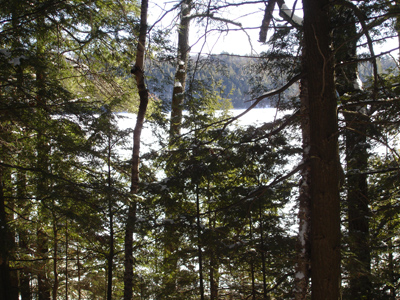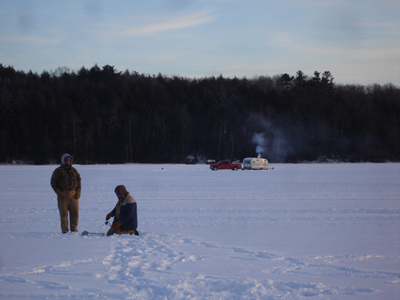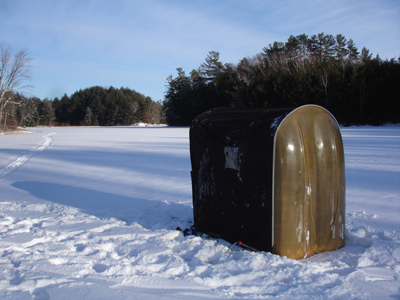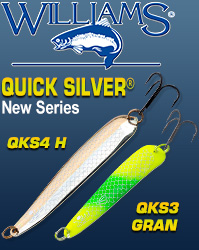FENCEROWS...Groundhogs on Ice
By John Luthens
February mornings in Wisconsin are dawning earlier. The glow in the eastern sky is getting steadily stronger as the sun shifts from its winter hibernation. And the groundhogs come out of their holes on the second day of the month to take a chance on the weather, possibly to welcome an early spring- or possibly to go back inside and bury beneath the covers for another month or so.
They roll out into the cold and snow to drill some exploratory holes in the ice. The ice may still be piling up; or it may have leveled off and started a downward sink into spring. Either way, the furry little waddling critters (those that live in the far northern climates, anyway) have reached the end of their winter rope when Groundhog Day rolls around. Temperature or relative wind chill factor isn’t going to stop them from finding out.
An archeological dig in the ice might find that the fossil remains of groundhogs provide the missing evolutionary link between ice fishermen and their ancestors. I came up with that theory myself last week, while in the Nicolet National Forest, in Oconto County, sitting in a beat-up shanty on a glacial iced lake, surrounded by towering hemlocks and white pine while eagles flew the shoreline.

The Lakewood region of Oconto County.
I only poked my head out of the shanty for quick bursts at the view. I was intently watching my jigging hole, and it was true that I didn’t want to miss any strikes, but it was also so cold outside, that I was afraid of freezing into an ice-sculpture statue, drifted over with snow and waiting for a wandering archeologist to discover me and ponder his own theory.
The Weather Channel called it a solid 10 below zero outside of the town of Lakewood where I was set up. There was a wind chill index of somewhere around minus 25 to minus 35, depending on the northern gusts. It was a day to discover if spring was around the corner. It was day for groundhogs on the ice.
Hunkered down against the elements, next to me in a groundhog shack of their own, were friends Tom Posselt and his son Wes.

Wes Posselt stands watchful over his dad, Tom, as he prospects a walleye hole in the deepening shadows.
Tom lives in Lakewood, a setting aptly named for its diversity of both forest and water. It’s a remnant area of virgin timber that steps back in time to the logging days of old, before the mightiest of the pines were cut from the ridges and rafted across lakes and ridden down the streams to the sawmills.
His son Wes hails from the Oshkosh area and grew up fishing Lake Poygan, Lake Winnebago and any other water that froze solid enough to drill a hole through.
It should be noted that I am only a notch above a groundhog in my ice fishing ability. Tom is much better, spending time in summer fishing structure breaks on the lakes around his home, marking up map grids, and perching on a jigging bucket in winter. And Wes is what you call a fish getter. If the fish are there, he’ll catch them. If they’re not, he’ll find out where they went.
On this particular groundhog outing, Wes set before us a study of glow-in-the-dark lures; Tom and I took it from there, bantering between the shack walls about how often to charge them, and under what type of light, and if it was even possible to make the lures glow too brightly and spook the fish.
It is a testament to the depths of insanity of an ice fisherman (namely me and about 18 inches on the lake we fished) that with sub-zero temperatures pounding the shack from above, he is willing to sprawl on his belly and giggle fanatically at how brightly the vertical jigging minnow is glowing in the hole. And if it happens to be a rattle minnow, you can press your ear down the hole to listen for the rattle’s vibration too.
Conversations, like the rattle minnows, reverberated through the walls of our respective shacks:
There were ethics involved in the relative size of the bluegill and perch we (mostly Wes) were catching. Tom held that the length of a pan fish should stretch from the tip of the fingers in an outstretched palm and cross above the wrist line before the fish can be thrown into the “keeper” bucket.
My contribution to the fish bucket was decidedly thin. I like to think I would have been better represented if I quit worrying about cold fingers, taking my gloves off for a proper measurement instead of dropping the catch back down the hole.
Lulls in the conversation occurred as the perch schooled beneath our shanty holes. It was a very sensitive bite. Sometimes it got too quiet in the other shack. I’d catch a few small ones, maybe miss a good strike or two; and nothing but dead silence from the other groundhogs.
“Marking anything bigger-or just the small ones like I’m getting over here?” I’d yell out the door.
“We’ve got nine keepers on the glow jigs.” The off-handed reply floated back.
This went on and on. I attribute it to the fact that the Posselts’ fish-measuring groundhog paws are a lot smaller than mine.
We solved the world’s political and economic problems from our groundhog fortresses: Gas prices are too high, wages are too low; our spouses are always wrong and our words of wisdom should rule in our households, instead of being banned, censored and relegated to secret ice house meetings on a remote lake.
We left the fiscal cliff issue alone. It was steep and rocky, not to mention confusing. I guess even ice shanty wisdom has its limits.

Shadows of a Groundhog Day ice shanty.
More or less, the only time we left the shacks was for lunch and to set tip-ups over a rocky hump. It wasn’t as steep as a fiscal cliff, but it was the best we had to work with. We sat and watched as night deepened, hoping for a cruising walleye to mouth one of our minnows and trip a flag.
The drifted snow of the lake was turning a dark purple when I packed to leave. The shoreline pines cast long shadows on the ice. We had enough fish, but the promise of walleye was strong.
And as far as groundhog promises go, I don’t know if the tree top shadows portended spring or extended winter. When I left for home, Tom and Wes were still hunkered in front of their shack, watching for flags and mulling it over.









